Here’s why scientists have been fertilizing the Arctic
Researchers are testing what a warmer future might bring by fertilizing Alaskan ecosystems
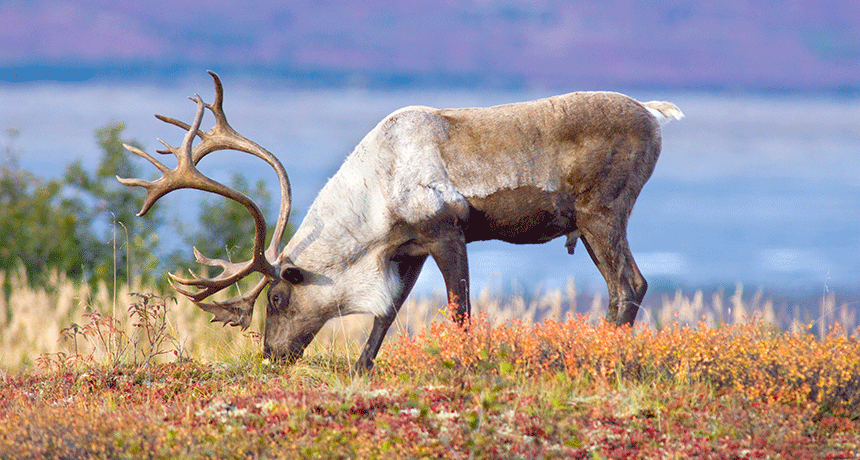
The far North isn’t a dead, ice-covered wasteland. It’s a beautiful, complex ecosystem teeming with life, from tiny plants to animals like caribou.
jamcgraw/istockphoto
Toolik Field Station, Alaska – High in the Arctic, more than 160 kilometers (100 miles) from the nearest town, there is a flimsy plank-covered path. Just one or two boards wide, it’s snow covered for nine months of the year. But from June to August, the boardwalk peeks through, threading a path through small rectangular plots of tundra — areas in the far North where most of the year it’s too cold and dark to support plants more than a few centimeters (inches) high.
Story continues below image.
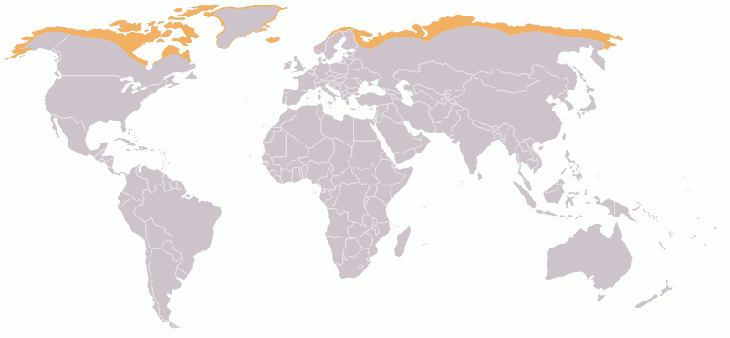
Some of these plots look exactly like the surrounding landscape. Low grassy tussocks, shrubs and moss fill them. Other patches — some open, others sheltered by small tarps — explode with life like unweeded gardens. There are tall, bright pink flowers waving in the breeze. Some bushes rise almost tall enough to be called a tree.
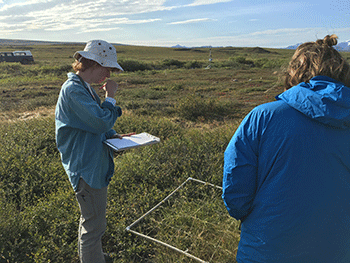
Laura Gough strides across the wooden planks between the tundra plots with practiced ease. At each plot, she stops and stares intently at the ground. Gough is a plant ecologist, someone who studies plant communities, at Towson University in Maryland. But in the summers she works here, at the Toolik Field Station in Alaska’s North Slope borough. She’s keeping an eye on a scientific experiment that has been running in one form or another for more than 40 years.
The fluffy, overgrown plant plots are no accident. Gough and her colleagues have been fertilizing their soil.
The goal is to learn how the Arctic will react when its soil is pushed to the limit. And nothing is pushing the Arctic to the brink quite like climate change. Across the globe, temperatures have been rising for decades. When people burn fossil fuels (such as coal, oil and gas), carbon dioxide (CO2) and other greenhouse gases spew into the atmosphere. They trap the sun’s heat, causing temperatures to rise. In the Arctic, those warmer temperatures will have a huge impact.
Throughout the high Arctic, vast expanses of permafrost — hard-frozen soil — sit just a few meters (yards) below the soil. As this region warms, more and more permafrost could thaw each summer. This soil contains old plants, microbes and the bones of animals. All have likely remained frozen for thousands of years. If the permafrost melts, those old plants and animals will finally begin to rot. They’ll break down into molecules containing nitrogen and phosphorus — chemicals that help plants grow. In a sense, then, that huge storage vault of frozen soil is full of natural fertilizer just waiting to be released.
Scientists don’t know exactly what will happen as the permafrost melts. But by creating a fertilized garden in the middle of the Arctic, Gough and her colleagues might find clues to how a melting permafrost will change the tundra. With 40 years of fertilizer and plenty of patience, the scientists may be able to predict the future — and show what a warmer tundra might look like.
Tending an Arctic garden
Plants need nitrogen and phosphorus to grow. Right now, the tundra has both nitrogen and phosphorus troubles. As organisms here die, they often become frozen in the permafrost instead of decomposing. This keeps their nitrogen trapped inside the tissues. Phosphorus is mostly bound up in the soil’s minerals. To free that phosphorus up for plants, active microbes are needed. But in the tundra, microbes tend to take life slow. “The microbes are frozen and wet,” Gough explains. In flooded, cold soil, the microbes can’t get the oxygen they need. This slows decomposition, she explains.
With nitrogen and phosphorus trapped in the permafrost, plants and other organisms don’t have much to live on. Over time, they’ve adapted to this starvation diet. But what would happen if nitrogen and phosphorus were suddenly freed? That’s where the Toolik experiment comes in.
Initially, the researchers wanted to see how environmental factors — such as temperature, light and nutrients — interact and affect plant growth, recalls Gaius Shaver. He’s a plant ecologist at the Marine Biological Laboratory in Woods Hole, Mass. Starting in 1976, he and other scientists began adding fertilizer to small plots of Arctic soil. At first they used an amount of fertilizer similar to what farmers added to their fields. That was many times more nitrogen and phosphorus than the Arctic plants could actually use.
Eventually the researchers decided to apply a more realistic amount — what plants in the tundra might actually encounter. That meant less fertilizer.
Life on the tundra moves at a glacial pace, and so that meant the scientists would have to fertilize — and collect data — for a very, very, very long time. They planned to spend as long in the Arctic as they could. Not just years. Decades.
When they started, climate change wasn’t really on their minds. “Climate change wasn’t very well understood. It wasn’t clear what was going to happen,” Gough recalls. The tundra fertilization research was just one of the many projects at sites around the world in what’s known as the Long-Term Ecological Research (LTER) network.
Scientists in this network perform many types of experiments. Some monitor what is happening. Others may alter the environment. Across the network, researchers have studied, among other things, how different ecosystems react over time to various levels of nutrients. Groups have actively fertilized spots of wetland, prairie, forest and more.
But just a few years into the tundra project, the scientists started thinking about temperature as well as plant food. After all, the Arctic is warming faster than the rest of the planet. If it got warm enough for more permafrost to melt, the researchers reasoned, nitrogen and phosphorus could flood into the ecosystem. Arctic plants would suddenly face an unexpected nutritional bounty.
Soon, scientists were not only adding nitrogen and phosphorus, but also adding plastic tarps to cover some plots. Under a small, plastic shed, the plants wouldn’t just get extra fertilizer, they’d also get extra warmth.
The slow creep of change
Things happen slowly in the Arctic. Even with climate change, it’s still only warm enough for plants to grow for three months of the year. But after more than three decades of fertilizing, warming and taking notes, ecosystem changes have emerged.
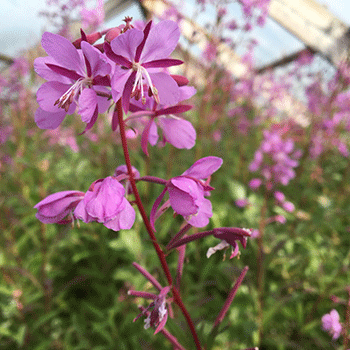
In fertilized plots of tundra, Shaver notes, plant growth can double. But the plants aren’t putting out more leaves. “Most of the plant matter in [the fertilized plots] is stems — woody stems,” Shaver says. “We’ve had this huge explosion of woody biomass.”
Those woody stems are new arrivals. Where a patch of tundra once had slow-growing grass tussocks, Gough says, the fertilizer helps woody shrubs move in. “We call it ‘shrubification,’” she says.
Yet a shrubby world isn’t as diverse as a grassy one. “We see a loss of many species,” Gough says. She’s also seen a proliferation of lovely pink flowers into her warm, fertilized plots. Those flowers are fireweed. And they shouldn’t be there. Fireweed is an invasive species. A weed. It’s supposed to live farther south, in forests below the tundra. But now it’s moving north, following people and their roads. “It’s gotten into almost every fertilized plot we maintain,” she says. The fireweed lives only in the fertilized plots. And where it thrives, it’s been forcing other plants out.
Fertilized fish
It’s not just plants that feel the difference. Nutrients don’t stay in one place, especially when water is involved. Over time, the nitrogen and phosphorus flow with the water. From the land, they head downhill, streaming into Arctic lakes and rivers.
Too much fertilizer can bring death to lake dwellers. Add nitrogen and phosphorus, and algae and plants bloom rapidly. At first, fish in the lake may grow rapidly with more plants to feed on. But as the greenery dies, it sinks to the bottom. There, the lake bottom’s microbial residents feast on rotting plant corpses. In the process, those microbes use up much of the oxygen in the water. As oxygen levels drop, other aquatic life, such as fish, can die. This process — called eutrophication — is well known in areas that have milder temperatures.
Fertilize an Arctic lake, Gough says, and the process is just the same. Adding nutrients “sucked the oxygen out of the lake,” she recalls. “Several long-term fertilization experiments had to be stopped because the scientists were afraid they were going to kill everything in [the water].” Scientists have continued to study the lakes, however, even after this fertilization stopped.
Now, even 10 years later, oxygen levels in the fertilized lakes have not recovered.
Once in a lake, fertilizer stays put. It remains stuck in stagnant water. But in a stream, it goes with the flow.
Feeding streams
Nitrogen and phosphorus spur the growth of algae, moss and tiny organisms called diatoms. Once these die, eutrophication still happens. But unlike in a lake, the water in the stream is moving. It mixes with the air, allowing more oxygen to get into the water. In streams, this leads to a different pattern of changes.
Linda Deegan is an ecologist at the Woods Hole Research Center in Falmouth, Mass. She has been adding phosphorus to freezing-cold streams in the Arctic for 30 years. Nitrogen runoff from the surrounding soil keeps nitrogen levels in the stream high enough for the plants in it to thrive. But phosphorus? “There’s no phosphorus in that water.” Because this nutrient is so limited, Deegan says, “the algae and plants sop it up as fast as they can.”
Deegan and her colleagues wanted to find out what would happen in streams if phosphorus levels got higher. So they dripped in enough phosphorus to increase the level five-fold. “We wanted to add enough that the stream would react, but not so much that we were blowing the socks off it,” she explains.
Over three decades, Deegan has found that phosphorus changed stream life in stages. Very long stages.
During the first few years, diatoms proliferated. These are tiny creatures that, like plants, make food from sunlight. And they need phosphorus to do it. At first, the piles of new diatoms offered a tasty snack for insects. “In the first few years, the insects had more food,” Deegan notes. And those insects in turn “were wonderful fish food.”
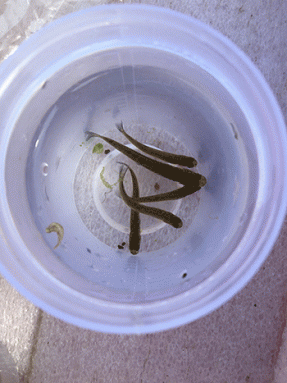
Only a few kinds of fish brave the tiny, freezing streams of Alaska’s high tundra. The most common species is the Arctic grayling. It breeds in the streams, leaving its offspring to fatten on the local bugs. With more insects about, baby grayling fattened up quickly.
But the changes didn’t last.
After four years of added phosphorus, the diatoms began to lose out to other species, such as long filaments of green algae that cling to the rocky bottoms of streams. And after eight years, those algae gave way to tufts of dark green moss. “The system itself evolved over time to accommodate the phosphorus,” Deegan observes.
Those changes trickled up the food web. “Once we converted over to moss, we got different insects in the community,” Deegan says. Now, she notes, “It was harder for the fish to feed.” The baby fish born each year in the streams had a good start in life with the insect buffet. Older fish didn’t fare as well.
By fertilizing streams, Deegan is getting a picture of what the Arctic could look like with less permafrost.
Every spring, the top layer of frozen Arctic soil thaws. This layer — called the active layer — gives rise to all life in the tundra. Over years of warming, that active layer will get deeper and deeper. What’s likely to result is “increased decomposition,” Deegan says. That, in turn, will likely release both nitrogen and phosphorus. But scientists don’t know how long that would take. “It’s not going to be years,” Deegan says. “It’s probably decades.”
The scientists no longer are adding fertilizer. Still, Deegan watches. She wants to see how the streams recover. “It’s important to understand not only how ecosystems respond when we push them, but how they respond when we stop pushing them,” she says. “We have it in our heads that the system will just snap back to where it was when it started. But the more we look the more we understand … these systems don’t always go back to where they started.”
Moving up the food web
Gough and Deegan are the latest in a line of scientists keeping an eye on fertilized tundra, streams and lakes. Gough started by watching grasses, tiny birches and other plants. Now she wants to find out what is happening higher in the food web.
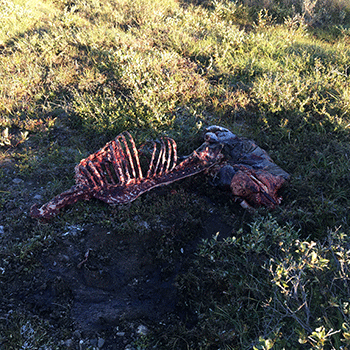
Some of her students, for instance, are studying local spiders. Gough has her own sights set on some of the tundra’s furrier inhabitants — voles and lemmings. “We’re really interested in how these mammals interact with plants and soils to affect carbon and nitrogen,” she says. Unlike larger mammals, such as bears and ground squirrels, Arctic voles and lemmings don’t hibernate all winter long. “They’re resident year-round,” she says. “They go under the snow, [and] we know that they have a big effect on plants and soils in a localized way.”
So for her next experiments, Gough is adding fences to the tundra. She hopes these will keep voles and lemmings in or out of certain sections. “We try to control their numbers and see what happens,” she explains.
Like the plant studies, these experiments will take many more years. “Because each year is so variable, data in one year may not represent long-term trends,” Gough explains. Scientists, therefore, need to look at tundra data from many years to get a good, long-term picture of what’s happening.
Scientists easily can spend their entire lives studying the Arctic. “I’ll keep going back for the rest of my career,” Deegan says. “The Arctic is a lot of things. It’s a wild and mysterious place we don’t understand. And I think it’s an early warning area for the kind of changes that can happen across the globe.”
This means repeat visits during the brief Arctic summers, as the flimsy boardwalk at the top of the world emerges from the snow and the streams temporarily flow once more. Year after year, Gough, Deegan, Shaver and many others will come back to walk the boardwalks, count the fish, insects and plants, repair their greenhouses and shiver in the icy streams.
The Arctic garden they are tending could help them — and us — see ahead to the tundra of the future.
Field reporting for this story was made possible by the Marine Biological Laboratory Logan Science Journalism Program.







